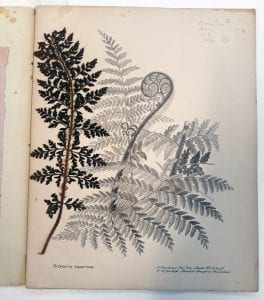It is late November 2018. We are in the Rare Room of the Morris Miller Library at the University of Tasmania, looking at Emily Harris’s New Zealand Flowers, New Zealand Berries and New Zealand Ferns. The University’s copies of Emily’s three books, published in Nelson by HD Jackson in 1890, are part of Special and Rare Collections, and librarian Heather Excell has brought them out for us this morning. The books are slim folios, each containing 12 drawings by Emily that were lithographed in London by John Walker and Company. Most sets are uncoloured but every now and then we come across copies hand-coloured by Emily herself between 1890 and 1910. There is always a moment of excitement as we open another copy, wondering if the title page will show us Emily’s watercolour additions and a signature.
We’ve learned to examine copies in the order Emily established and to work through each book noting its condition and any interesting details. The University of Tasmania copies are uncoloured, were once in another part of the library and carry no traces of how or when they came into Special and Rare Collections. Our notes for Flowers and Berries are pretty standard:
No hand-colouring. Fully intact. Binding better in Flowers than Berries. Condition excellent – internal pages totally free from foxing. No previous owner signature/ no association. No acquisition info, previously in the Bio-Medical library. Catalogued as Rare from acquisition. Likely donated and added to the collection.
Then we open New Zealand Ferns and find a fern in the pages of the book. Dry and delicate, it is pressed with Emily’s drawing of the tree fern Dicksonia squarrosa. To judge by the frond formation the pressed fern is unlikely to be a Dicksonia, and yet there is a similarity, and in being placed alongside an actual fern Emily’s fern seems more real than it has before.
In all there are six ferns pressed in the pages of the book, each one between pink blotting paper on which someone has written in blue pencil. The page with Emily’s drawing of Asplenium flaccidum has a fern pressed between blotting paper but also a page from an 1869 diary with September entries about surveying in the Waimea district on the West Coast of the South Island.
Questions unfurl like young fern shoots. Did the writer of the diary press these ferns into the book? Was he a surveyor in Westland in 1869, when the goldfields at Hokitika, Kaniere and Waimea were in full production? Was he one of several surveyors who sent or brought botanical specimens to Emily Harris in Nelson?
With such specific dates and places it might be possible to reconstruct at least part of the story so materially attached to the Hobart copy of Emily’s New Zealand Ferns.
Lead writer: Michele Leggott
Research support: Makyla Curtis, Betty Davis

